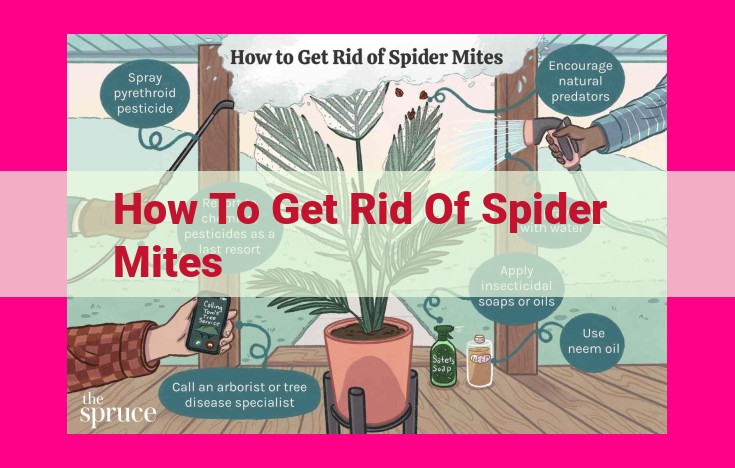Comprehensive Spider Mite Control: Integrated Pest Management, Biological Control, And Scientific Advancements

To combat spider mites, begin by introducing predatory mites and implementing biological pest control measures. Integrate pest management strategies and consider the influence of plant health and garden hygiene. If necessary, apply acaricides. Advancements in scientific research, including studies on spider mite biology, acaricide development, integrated pest management, and plant resistance, provide valuable insights for effective spider mite control.
Understanding the Menace: Introducing Spider Mites
Meet the Notorious Arachnids
Step into the hidden world of spider mites, a microscopic menace that can wreak havoc on your beloved greenery. These tiny creatures belong to the arachnid family, related to ticks and spiders. Among the most common species is the common spider mite, Tetranychus urticae, a prolific pest that can infest a wide range of plants.
Spotting the Telltale Signs
Identifying spider mites requires a keen eye. They are usually bright green or red and can be as tiny as 0.5 millimeters in size. Look closely for fine webbing on the undersides of leaves, a telltale sign of their presence. As their infestation progresses, plants may exhibit yellowish or pale spots, leaf curling, and loss of vigor. Severe infestations can lead to leaf drop and plant death.
Their Dastardly Diet
Spider mites feed on plant sap, using their piercing mouthparts to puncture cells and extract nutrients. This causes plant damage and disrupts normal plant functions. They prefer dry and dusty conditions and thrive in hot and humid environments. Once they establish an infestation, they can spread rapidly, multiplying quickly and leaving behind a trail of destruction.
Pest Control Measures: Combating Spider Mite Infestations
Predatory Mites: Nature’s Allies in Mite Management
When faced with a spider mite infestation, predatory mites emerge as unlikely heroes. These tiny insects, such as the Phytoseiulus persimilis and Amblyseius fallacis, are voracious hunters of spider mites, effectively reducing their populations and restoring balance to your garden.
Biological Pest Control: Harnessing the Power of Nature
Beyond predatory mites, a plethora of biological pest control options exist to combat spider mites. Introducing ladybugs, lacewings, and parasitic wasps into your garden empowers these natural predators to feed on spider mites, curbing their spread.
IPM: A Holistic Approach to Spider Mite Management
Integrated pest management (IPM) emphasizes a comprehensive approach to spider mite control. This strategy combines multiple methods, such as cultural practices, biological control, and judicious use of acaricides, ensuring long-term effectiveness while minimizing environmental impact.
Acaricides: The Chemical Option
When other methods prove insufficient, acaricides provide a chemical solution for spider mite control. These pesticides target specific stages of the spider mite life cycle, disrupting their development or killing them outright. However, judicious use is crucial to avoid resistance and harm to beneficial insects.
Ecological Factors Influencing Spider Mites
In the intricate tapestry of our gardens, spider mites play a pivotal role in the delicate balance of nature. Understanding the ecological factors that influence their populations is paramount to managing them effectively and sustainably.
Plant Health: A Key Player
Thriving plants with robust immune systems are less susceptible to spider mite infestations. Healthy plants produce natural compounds that deter these tiny pests. Providing adequate sunlight, nutrients, and water helps plants build strong defenses against spider mites. Conversely, stressed plants are more attractive to mites, making them easy targets.
Garden Hygiene: A Preventive Measure
Maintaining a clean garden environment can significantly reduce spider mite populations. Regularly removing fallen leaves, plant debris, and weeds eliminates potential hiding places and breeding grounds for these pests. Good garden hygiene also promotes air circulation, which helps deter spider mites.
Tools for Detection: A Crucial Step
Early detection is essential in managing spider mites effectively. Armed with a hand lens or microscope, gardeners can closely inspect their plants for signs of infestation. Leaf inspection reveals telltale symptoms such as stippling, yellowing, and webbing, indicating the presence of spider mites. Regular monitoring allows for timely intervention, preventing the spread of infestations.
By considering the ecological factors influencing spider mites, gardeners can develop comprehensive management strategies that minimize the impact of these pests while promoting the health and vitality of their plants.
Scientific Frontiers in Spider Mite Management
In the realm of science, researchers delve into the intricacies of spider mites, seeking to uncover their secrets and develop groundbreaking strategies for their control.
One area of investigation focuses on understanding spider mite biology and ecology. Scientists meticulously study their life cycles, behavior, and interactions with host plants to gain insights into their population dynamics. This knowledge enables the development of targeted control measures that disrupt their reproduction and survival.
Acaricide development is another key research area. Scientists explore novel chemical formulations and application techniques to improve the efficacy and specificity of treatments while minimizing environmental impact. By selectively targeting spider mites, these advancements reduce the risk of harm to beneficial organisms and support sustainable pest management practices.
Integrated pest management (IPM) approaches integrate multiple control tactics to holistically manage spider mite infestations. Research investigates the effectiveness of combining biological control, cultural practices, and selective pesticide use to achieve long-term suppression while preserving ecosystem balance. IPM strategies emphasize prevention, monitoring, and threshold-based interventions, ensuring timely and cost-efficient pest control.
Finally, scientists are exploring plant resistance to spider mites. By identifying and breeding plants with natural defenses, researchers aim to develop cultivars that naturally deter or tolerate spider mite infestations. This genetic approach offers a promising avenue for sustainable pest management, reducing reliance on chemical treatments and promoting plant health.
These ongoing research efforts pave the way for innovative and environmentally conscientious spider mite management solutions. As scientists continue to unravel the secrets of these persistent pests, we can anticipate advancements that empower growers and home gardeners alike to effectively protect their plants from spider mite damage.